
The author in contemplation with a glass of pink champagne while French friends sample dubious delectables from a Norwegian specialties stall at a fair in the village of Ay, Champagne.
About Me
My early education was at technical schools in Sunshine and Footscray in the west of Melbourne where I developed great admiration for the skills of good tradesmen. During this time I began to be fascinated by fossils, taking my collections into the museum for expert identification. There, I was encouraged to sit at a table and draw the fossils. ‘You do not see anything until you draw it’, I was told. Sage advice I have never forgotten. From this experience I learned to see the detail in everything, and the way classification makes sense of things.
Subsequently, I joined the National Museum staff as an assistant curator while proceeding with studies in earth sciences at Melbourne University. A master’s degree there lead to doctoral and post-doctoral studies at Cambridge and Harvard. My first full-time job was Lecturer in Mineralogy at the University of Queensland. After some years there, I joined the Commonwealth Scientific and Industrial Research Organization in Sydney. I made frequent working visits to institutes and universities in France and China, and authored or co-authored more than 100 research papers on subjects related to the origin of ore deposits and petroleum accumulations.
For many years my wife and I were fortunate to own a house in the Midi of France where on yearly visits, I continued to inquire into poetic subjects both real and surreal. In travels all over China with Chinese colleagues I endeavored to penetrate the uniquely Chinese view of the world, with inevitable influence on my writings.
I have profited enormously from a happy family, and friends in poetry groups at Writing NSW, Eastwood and Pennant Hills.
With reference to this website, my long-term hobby (forever observing and classifying) has been identification of many of the more than 900 species of eucalypt trees that have adapted to almost every possible ecological niche over the continent of Australia. The bark of these trees is important in identification, and the presentation of figures accompanying the poems, is a symbolic way to indicate that my poetic writings are nourished by the botanical studies that are done in parallel.